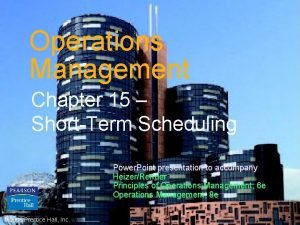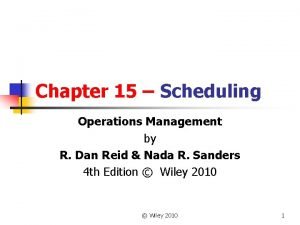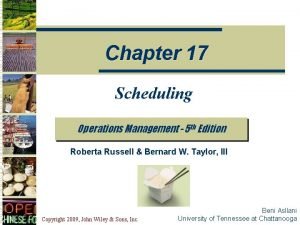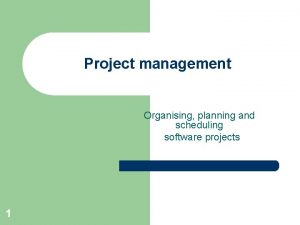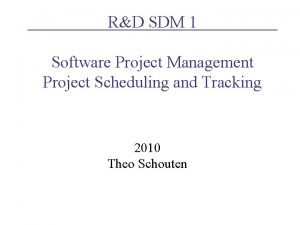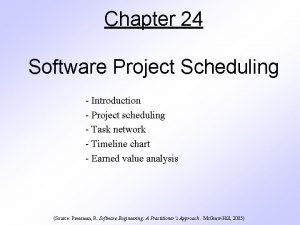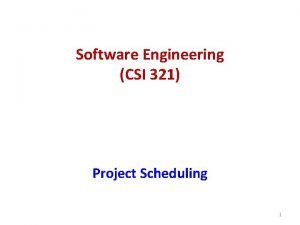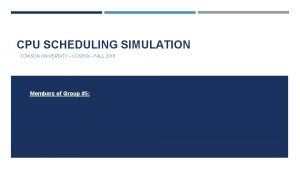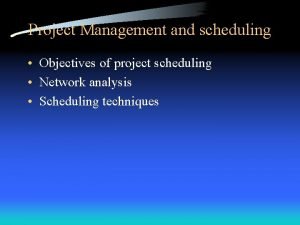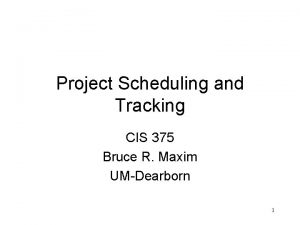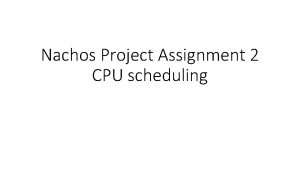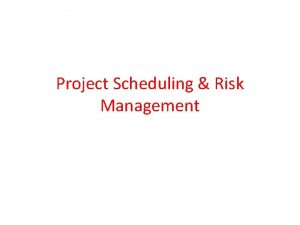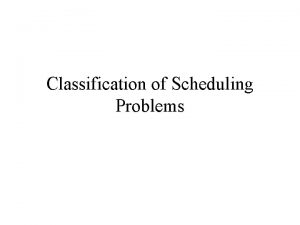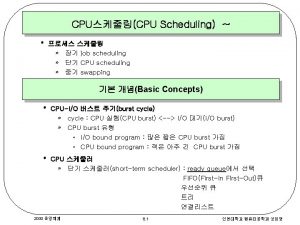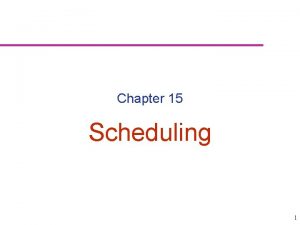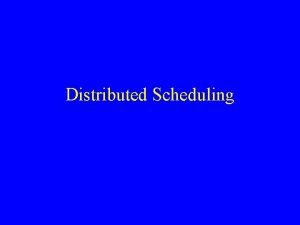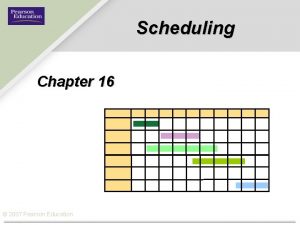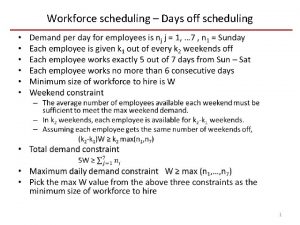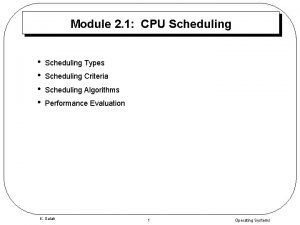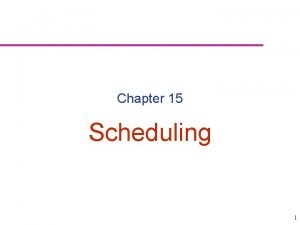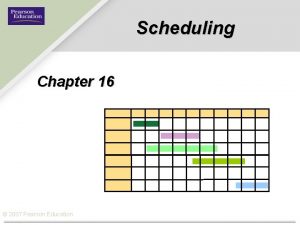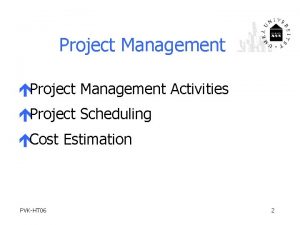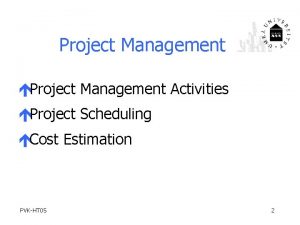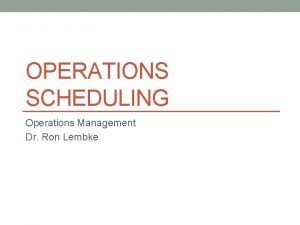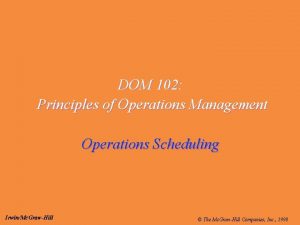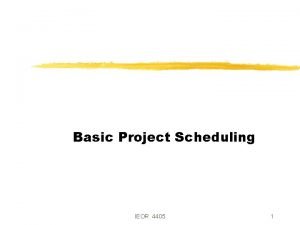Operations Management Session 27 Project Management Scheduling the









































- Slides: 41

Operations Management Session 27: Project Management

Scheduling the Project From Action Plan and WBS to Gantt chart and project network. w Gantt Chart w Project Network n n Activity-on-arrow Activity-on-node w CPM and PERT w Risk analysis involves determining the likelihood that a project can be completed on time n n Statistics Simulation Session 27 Operations Management 2

Scheduling the Project Session 27 Operations Management 3

History Late 1950 s v v Critical Path Method (CPM) § Dupont De Nemours Inc. developed the method § Deterministic activity durations Program Evaluation and Review Technique (PERT) Session 27 § U. S. Navy, Booz-Allen Hamilton, and Lockeheed Aircraft § Probabilistic activity durations Operations Management 4

w Activity The Language of PERT/CPM n Task or set of tasks n Takes time and needs resources w Precedence Relationships n The immediate predecessor activities w Event n n Completion of one or more activities (to allow the next activity or activities to start) Zero duration, zero resource w Milestones n Significant events – showing completion of a significant portion of the project Session 27 Operations Management 5

The Language of PERT/CPM w Network n Diagram of nodes connected by directed arcs n Shows technological relationships among activities w Path n A set of connected activities such that each activity on both sides is connected to one and only one other activity (with exception!). w Critical Path n A path where a delay in any of its activities will delay the project n The longest path on the network n The shortest time to complete the project w Critical Time n The total time to complete all activities on the critical path Session 27 Operations Management 6

Two Types of Network Diagrams w Activity-on-Arrow Network (Arrow Diagramming Method) n Easier to show events and milestones n More compatible with network theory techniques n Sometimes requires dummy (artificial) activities w Activity-on-Node Network (Precedence Diagramming Method) n Easier representation n No dummy activity Session 27 Operations Management 7

Activity on Arrow Network An Activity is an arc with two nodes at its beginning and its end a b c d Session 27 Operations Management 8

Ao. A: Activity Predecessors A list of immediate predecessors is needed. Task Predecessor a -- b a c b Task Predecessor a --- b -- c b d a Session 27 a b c a d b c Operations Management 9

Ao. A: Activity Predecessors Task Predecessor a --- b a c a d a b a c d Task Predecessor a --- b -- c -- d a, b, c Session 27 a d b c Operations Management 10

Ao. A May Need Dummy Activity w Two activities have the same starting and ending nodes w A single activity connects to two or more nodes Task Predecessor a --- b a c a d b, c b d a c w Try this: a, b c and a, d e Session 27 Operations Management 11

Ao. A: A Power Plant Construction Project Task Description Predecessor a Design & engineering --- b Select site a c Select vendor a d Select personnel a e Prepare site b f Manufacture generator c g Prepare operation manual c h Install generator e, f i Train operators d, g j Obtain license h, i Session 27 Operations Management 12

Ao. A: A Power Plant Construction Project b a e c d Session 27 f g h i Operations Management j a: b: a c: a d: a e: b f: c g: c h: e, f i: d, g j: h, i 13

Draw Ao. N Network a: b: a c: a d: a e: b f: c g: c h: e, f i: d, g j: h, i Session 27 Operations Management 14

Draw AOA Session 27 Operations Management 15

Transform into AON d=4 2 6 b=2 1 3 i= 4 k= 4 g=9 7 5 j= c= 8 = f 3 Session 27 6 7 a= e= 6 h=9 5 Operations Management a: b: c: d: a e: a f: c g: b, e, f h: c i: b, e, f j: h k: d, i 16

Draw Ao. N Network a: b: c: d: a e: a f: c g: b, e, f h: c i: b, e, f j: h k: d, i Session 27 Operations Management 17

Critical Path and Critical time w The critical path is the shortest time in which a project can be completed w If a critical activity is delayed, the entire project will be delayed. w There may be more than one critical path. w Brute force approach to finding critical path: 1. identify all possible paths from start to finish 2. sum up duration of activities on each path 3. largest total indicates critical path Session 27 Operations Management 18

Critical Path Method: The Network 4 6 A 1 A 3 S 4 3 A 4 A 6 3 2 A 5 Session 27 E Find the Critical Path. Operations Management 19

Critical Path Method: Paths 4 6 A 1 A 3 S 3 A 2 How many path? E 4 3 A 4 A 6 2 A 5 10 11 8 Critical Path is the longest path. It is the shortest time to complete the project Session 27 Operations Management 20

Forward Path; Earliest Starts 6 4 4 A 1 00 4 A 3 4 10 A 4 4 0 4 3 0 A 2 0 Session 27 3 2 E 11 11 3 4 0 S 10 8 8 5 A 6 8 11 A 5 3 3 5 Operations Management 21

Forward Path 10 30 20 Max = 30 35 35 35 5 Session 27 Operations Management 22

Backward Path; Latest Starts 0 4 4 A 1 00 00 S 03 5 4 6 11 5 4 4 4 0 3 0 Session 27 4 6 2 6 6 A 2 3 4 A 4 4 3 11 A 3 4 10 8 8 A 5 3 3 11 10 E 11 8 8 5 3 1111 A 6 8 11 8 5 Operations Management 23 11

Backward Path 30 30 30 Min = 35 35 45 30 5 Session 27 Operations Management 24

Activity Slack w Slack, or float: The amount of time a noncritical task can be delayed without delaying the project w Slack—LFT – EFT or LST – EST w EST—Earliest Start Time n Largest EFT of all predecessors w EFT—Earliest Finish Time n EST + duration for this task w LFT—Latest Finish Time n Smallest LST of following tasks w LST—Latest Start Time n LFT – duration for this task Session 27 Operations Management 25

Computing Slack Times EST EFT Task = duration slack = xxxx LST Session 27 LFT Operations Management 26

Critical Path, Slacks 0 4 4 5 11 11 A 3 A 1 0 6 4 4 4 S 4 E 10 8 8 A 4 3 3 6 4 6 A 2 0 Session 27 2 3 11 A 6 8 8 8 11 A 5 3 3 5 Operations Management 27 11

Slack Times Example Task Pred. Dur. a -- 4 g c, d 1 b -- 3 h e 4 c a 3 i f 5 d a 2 j e, g 6 e b 6 k h, i 1 f b 4 For each task, compute ES, EF, LS, slack Session 27 Operations Management 28

Slack Times Example c=3 slack= LST Task=dur slack=xxx EST g=1 slack= a=4 slack= EFT j=6 slack= d=2 slack= Finish Start e=6 slack= h=4 slack= b=3 slack= Session 27 LFT k=1 slack= f=4 i=5 slack= Operations Management 29

Activity Times in PERT w Optimistic (a) n Activity duration to be ≤ a has 1% probability. ≥ a has 99% probability w Pessimistic (b) n Activity duration to be ≥ b has 1% probability ≤ b has 99% probability w Most likely (m) n The mode of the distribution w All possible task durations (or task costs) can be represented by statistical distributions Session 27 Operations Management 30

Beta Distribution: The Probability Distribution of Activity Times Session 27 Operations Management 31

Activity Expected Time and Variance w Mean, “expected time” TE = (a + 4 m + b)/6 w Standard deviation, = (b-a)/6 w Variance 2 = [(b-a)/6]2 Session 27 Operations Management 32

95% & 90% Levels w If we replace 99% with 95% or 90% levels n Activity duration to be ≤ a has 5% probability n Activity duration to be ≥ b has 5% probability n Activity duration to be ≤ a has 10% probability n Activity duration to be ≥ b has 10% probability Session 27 Operations Management 33

Probability of Completing the Critical Path on Time w We assume the various activities are statistically independent of each other w Individual variances (and mean) of the activities on a path can then be summed to find the variance (mean) of the path w Determine the mean and standard deviation of the critical path w Compute the probability of critical path being ≤ a Session 27 Operations Management 34

The Probability of Completing the Critical Path on Time DCP = the desired completion date of the critical path m. CP= the sum of the TE for the activities on the critical path 2 CP = the sum of the variances of the activities on the critical path Given Z, the probability of having the standard normal variable being ≤ Z is the probability of completing the project in a time ≤ D Session 27 Ardavan Asef-Vaziri Operations Management 35

Selecting Risk and Finding D Select the probability of meeting the completion date and solve for the desired date, D Using the probability, you can compute Z and then solve for D 11/27/2020 Session 27 Operations Management 36

Probability of Completing a Project on Time w Find all paths in the network w Compute mean and standard deviation of each path w Compute the probability of completing each path in ≤ the given time w Calculate the probability that the entire project is completed within the specified time by multiplying these probabilities together Session 27 Operations Management 37

Critical Path Method: Paths Suppose all activities have beta distribution 4, 1 A 1 6, 2 A 3 E 3, 1 4, 1 S A 4 3, 0. 5 A 2 2, 0. 5 A 6 10 11 8 The first number is the mean; the second is standard deviation. Session 27 Operations Management 38

Probability of Completing CP in 12 days What is the probability of competing the critical path in a maximum of 12 days? DCP = the desired completion date of the critical path m. CP= 4+4+3 = 11 2 CP = 12+12+12 = 3 CP = 1. 73 Z= 0. 58 P(z≤ 0. 58) = 0. 72 Session 27 Operations Management 39

Selecting Risk and Finding CP Time With a probability of 90%, in how many days will the CP be completed? From Standard Normal Table Z 90% = 1. 28 Session 27 Operations Management 40

Probability of Completing The Project in 12 days The probability of completing the critical path in not more than 12 days was 0. 72. We need to compute this probability for blue path and green path too, and then multiply these probabilities m. CP= 6+4 = 10 2 CP = 12+22 = 5 Z= (12 -10)/2. 24 = 0. 89 P(z≤ 0. 89) = 0. 81 CP = 2. 24 m. CP= 3+2+3 = 8 2 CP = 0. 52+12 = 1. 22 Z= (12 -8)/1. 1 = 3. 63 P(z≤ 3. 63) ≈ 1 CP = 1. 1 The probability of competing the Project in not more than 12 days is 0. 72× 0. 81× 1 = 0. 58 Session 27 Operations Management 41
 Scheduling process-focused facilities
Scheduling process-focused facilities Operations scheduling definition
Operations scheduling definition Scheduling rules operations management
Scheduling rules operations management Sjn scheduling
Sjn scheduling Project scheduling
Project scheduling Importance of software project management
Importance of software project management Sdm project management
Sdm project management Scheduling principles in software engineering
Scheduling principles in software engineering Pnr curve in software engineering
Pnr curve in software engineering Project scheduling
Project scheduling Project scheduling and tracking
Project scheduling and tracking Cpu scheduling project
Cpu scheduling project Forward pass scheduling
Forward pass scheduling Project scheduling and tracking software quality assurance
Project scheduling and tracking software quality assurance Cpu scheduling project
Cpu scheduling project Quality management in operations management
Quality management in operations management Operations management chapter 12 inventory management
Operations management chapter 12 inventory management Operations management with total quality management book
Operations management with total quality management book Hát kết hợp bộ gõ cơ thể
Hát kết hợp bộ gõ cơ thể Lp html
Lp html Bổ thể
Bổ thể Tỉ lệ cơ thể trẻ em
Tỉ lệ cơ thể trẻ em Gấu đi như thế nào
Gấu đi như thế nào Tư thế worms-breton
Tư thế worms-breton Hát lên người ơi
Hát lên người ơi Các môn thể thao bắt đầu bằng tiếng nhảy
Các môn thể thao bắt đầu bằng tiếng nhảy Thế nào là hệ số cao nhất
Thế nào là hệ số cao nhất Các châu lục và đại dương trên thế giới
Các châu lục và đại dương trên thế giới Công của trọng lực
Công của trọng lực Trời xanh đây là của chúng ta thể thơ
Trời xanh đây là của chúng ta thể thơ Cách giải mật thư tọa độ
Cách giải mật thư tọa độ Phép trừ bù
Phép trừ bù độ dài liên kết
độ dài liên kết Các châu lục và đại dương trên thế giới
Các châu lục và đại dương trên thế giới Thơ thất ngôn tứ tuyệt đường luật
Thơ thất ngôn tứ tuyệt đường luật Quá trình desamine hóa có thể tạo ra
Quá trình desamine hóa có thể tạo ra Một số thể thơ truyền thống
Một số thể thơ truyền thống Cái miệng bé xinh thế chỉ nói điều hay thôi
Cái miệng bé xinh thế chỉ nói điều hay thôi Vẽ hình chiếu vuông góc của vật thể sau
Vẽ hình chiếu vuông góc của vật thể sau Biện pháp chống mỏi cơ
Biện pháp chống mỏi cơ đặc điểm cơ thể của người tối cổ
đặc điểm cơ thể của người tối cổ V cc
V cc
